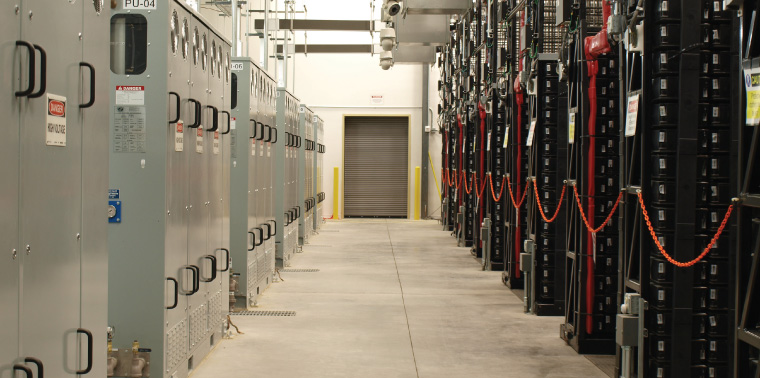Waste and reliability. To meet peak levels of demand, the grid has been massively overbuilt. The Electric Power Research Institute estimates that one-quarter of all high-voltage distribution lines and about one-tenth of all power plants are used, on average, just 5 percent of the time, or 33 hours per month.
That means hundreds of billions of dollars in assets go unused the vast majority of the time. Utilities are recognizing that carefully targeted storage can cost-effectively replace these least-used assets, says Haresh Kamath, program manager for energy storage at EPRI.
“We’re not using most of our assets most of the time,” says Johannes Rittershausen, managing director of Convergent Energy + Power, a developer of energy storage assets. “The challenge is to find ways to address infrastructure needs most efficiently and at the least cost to end users. A well-designed energy storage project can do just that by taking advantage of slack capacity in targeted locations.
“The U.S. grid will require massive investment over the coming decades as infrastructure ages and our society’s peak electricity demand continues to grow,” he adds.
Renewables’ risks. As a rule of thumb, grid experts believe that when intermittent power sources such as wind and solar surpass 20 percent, grid instability soars. And where that figure once seemed high, it is routinely being surpassed in many regions.
Storage boosts the value of renewables in two ways: by stepping in to provide power when renewable output drops off, and by mopping up excess output when solar or wind power exceed demand.
In February of this year, wind output set a record in Texas, briefly cranking out more than 28 percent of the power demands of the Electric Reliability Council of Texas, which manages the flow of about 85 percent of the state’s electric power. California’s goals for renewables are the nation’s highest, with a mandate to hit 33 percent by 2020. Roughly 20 more states, home to the majority of the U.S. population, have set goals of 20 percent or more.
Storage boosts the value of renewables in two ways: by stepping in to provide power when renewable output drops off, and by mopping up excess output when solar or wind power exceed demand.
“For the first time, the growth of renewables means we’re facing unpredictable supply,” says Lin. Demand will also grow less predictable as more electric vehicles come on line. “Plus it’s hard to find locations for new plants or transmission lines,” Lin adds. “Storage speaks to all these problems.”
Top Contenders
A menagerie of exotic new storage technologies — including thermal storage, flywheels and compressed air storage — are developing fast, but haven’t yet achieved commercial-scale viability. For now, advanced battery-based storage is the hottest of the grid’s newcomers, thanks to rapid declines in the price of Li-ion batteries.
Serendipitously, a key impetus for this trend started in the auto sector, where rising sales of battery-packed hybrids and electric vehicles are driving carmakers’ appetites for advanced Li-ion batteries. This is spurring new manufacturing capacity, driving prices down globally. Driven largely by rising demand from car companies, industry and utilities, the global Li-ion market is slated to double over the next four years, to around $24 billion, according to a recent Frost & Sullivan report.
As prices fall, Li-ion batteries are finding new niches. For now, at around $2,000 per kilowatt-hour, battery backup remains too costly for most applications. But they do pencil out for deep-pocketed utilities in key situations, where their ability to deliver large pulses of power is highly valued.
In January, for example, Duke Energy completed a 36 MW energy storage system at its Notrees Windpower Project in West Texas. Designed and installed by Austin-based Xtreme Power with funding from the U.S. Department of Energy, the $44-million system is the world’s largest wind-linked storage unit, made up of thousands Li-ion battery cells.
According to financial service company UBS, the cost of storage dropped by 40 percent over the past two years, and analysts expect the slide to continue, or even accelerate. At around $500 per kWh, EPRI estimates more than 40,000 MW of potential demand will enter the market. At that price point, residential-scale battery backup may become a reality. Pilot trials of such household-scale backup appliances are underway near Sacramento, Calif.
Installed in the garages of 15 solar-powered homes, Li-ion battery packs the size of small file cabinets hold enough juice to supply a few hours of power. The systems are designed to let the homes go off grid during periods of peak demand, saving homeowners money while reducing stress on the network.
Ensia shares solutions-focused stories free of charge through our online magazine and partner media. That means audiences around the world have ready access to stories that can — and do — help them shape a better future. If you value our work, please show your support today.
Yes, I'll support Ensia!

It purely talks about $ per kWh. However the reference used to back up "could be on track to decline by another 50 percent by 2020, to $300 to $600 per kWh" is in fact to a site that talks about storage dropping to $300 to $600 per kW, not kWh.
The website linked to also gives the costs in Australian, not US dollars.
Before making optimistic prognostications about costs reductions in battery storage it may be best to check that the numbers stack up first.
Robert Wilson
http://carboncounter.wordpress.com/
"California isn’t facing an imminent energy crisis, nor would renewables be to blame if such a thing occurred. What California is really facing is the need to add flexible capacity to its energy supply mix."
You say, "as a rule of thumb, grid experts believe that when intermittent power sources such as wind and solar surpass 20 percent, grid instability soars." However, DOE studies such as the Western Wind and Solar Integration Study have found that this is not the case. Even for renewable penetrations in excess of 30%, they did not find a need for storage. It was not even cost-justified to build more pumped hydro.
There will certainly be localized situations where storage will first be cost effective, such as the peak shaving opportunities that you discuss in the article or to help put more distributed solar energy on weak distribution feeders, but I don't see evidence that large-scale storage will play a major role (or be required) for higher penetrations of renewables in the general case.
I agree with the comment that you posted above about California - they need flexibility in their system. But it is interesting to note that well functioning power markets like ERCOT in Texas and MISO in the Midwest, where they dispatch wind energy and almost all conventional generators participate in the market, do not have the same concern as California. For complex reasons, most conventional generators in California do not allow the market system to dispatch their units, so even the flexibility that exists is often not available to the system operator. Hopefully they will find ways to fix that as well as add more flexible capacity.
While IA and SD are small demand pools, these records reinforce the point that grid operators, especially in the wind-rich Midwest and Texas (n.b.: Texas has more installed wind capacity than the U.K.), are fast learning to better manage big volumes of variable renewables. As this post at World Resources Institute explains, more states are headed towards this threshold, too: wind topped 10 percent for the full year in seven other states (North Dakota, Minnesota, Kansas, Colorado, Idaho, Oklahoma, Oregon).
You raise a good point about the deep role of regulations here. They are vexingly complex within each market, and vary from region to region. I’ve heard industry players repeatedly point out that many of the technical regulatory rules governing the grid were set out decades ago, meant to ensure stability at all costs, but today have the unintended effect of locking out newer technologies.
In a negative example, grid rules here in the NY region — and many others, I understand — meant that owners of solar-powered houses were surprised to discover they couldn’t tap their own panels when the wider grid went down after Superstorm Sandy. But change is afoot, if slowly. In a good example, federal grid rules were recently revised to reward providers of a type of very short term grid storage (known as frequency regulation) in such a way that advanced flywheels are winning-out over incumbent fossil fuel plants.
The addition of storage is a facet of the larger, long-term rehab of our aging grid. And however quickly storage scales up, we need to continue to upgrade the hardware and software that manages the grid. A smarter grid opens the door to much larger flows of renewables, while also lowering the risk of blackouts.